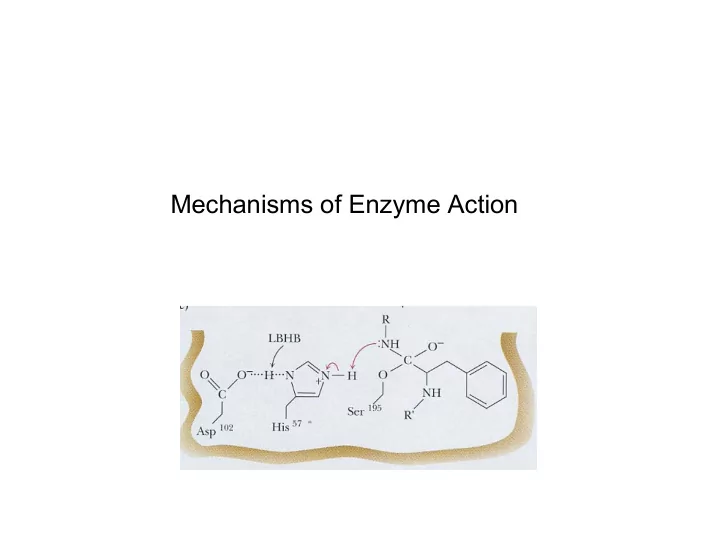

Mechanisms of Enzyme Action
Kinetics of an uncatalyzed chemical reaction: S S* P Free energy, Δ G “Reaction coordinate” Ea is “activation energy”
Kinetics of a catalyzed chemical reaction: S + E ES ES* EP E + P Free energy, G “Reaction coordinate” 1. Enzyme does not affect Δ G or Δ G o between S and P (i.e., equilibrium) 2. Enzyme reduces Ea: Ea (catalyzed) < Ea (uncatalyzed)
A more complete way of showing the effects of enzymes: Enzymes bind to substrates, so G(ES) < G(E+S). However, if all they did was to bind, then Ea = Δ G(ES*) for the reaction would not be reduced. So when they bind the substrate, they stress It in some way, raising G(ES) for part of the substrate and reducing Δ G(ES*)(=Ea).
Quantitatively, what is the effect of reducing Ea? For reaction A B, V = k[A] k = ( T/h)exp(-Ea/RT) = Boltzman’s constant; h = Plank’s constant, So k and thus V are inversely and exponentially related to Ea and directly related to T: A 6 kJ/mol reduction in Ea gives ca 10x increase in k and V k ~ exp(+6000/8.3*300) ~ 11 (reduction in Ea is an increase from –Ea) V(catalyzed)/V(uncatalyzed) for various enzymes varies from 104 to 1021, meaning Ea is reduced by ca 23 to 126 kJ/mol
How do enzymes reduce Ea? These effects raise G(ES): cage effect, orientation, steric straining of bonds (stress from H-, Vanderwaal’s, ionic bonds), dislocation of bonding electrons through +/- charges These effects reduce G(ES*): covalent bonds, acid- base catalysis, low-barrier hydrogen bonds, and metal ion catalysis Different classes of enzymes may use different mechanisms: 1. Oxidoreductases (oxidation-reduction reactions) 2. Transferases (transfer of functional groups) 3. Hydrolases (hydrolysis reactions) 4. Lyases (addition to double bonds) 5. Isomerases (isomerization reactions) 6. Ligases (formation of bonds with ATP cleavage)
Examples: Orientation , Cage effect Strain Charge effects , Covalent bonds, Acid-base catalysis
An example of an enzyme that sterically strains the substrate: Lysozyme Hydrolysis distorts the bonds breaks the of one of the polysaccharide sugars in the chain and polysaccharide weakens of a bacterial the wall so cell wall that the cell lyses. It also places a partial charge on the substrate, making it react more easily with water (hydrolysis).
Example of an enzyme mechanism using covalent bonds, acid-base catalysis, low-barrier hydrogen bonds Serine protease (e.g., trypsin, chymotrypsin, acetylcholinesterase): hydrolyzes peptide bond of proteins (or acetylcholine), substrate (A-CO-NH-B) + H2O A-COOH + H2N-B Asp-His-Ser = DHS
e - movement Low-barrier hydrogen bond: e - movement
(same picture as previous)
Cleavage of the peptide bond Release of the amino product
(same picture as previous)
e - movement e - movement ser-substrate bond breaks
(same picture as previous)
DHS regenerated
Specificity of reaction: depends on DHS in active site Specificity of substrate: geometry of the activity site Note the pH dependence: >6 needed for hiso
Summary Enzymes speed reactions by reducing Ea Enzyme reduce Ea by stressing substrate (raising G(ES)) and by reducing G(ES*) Lysozyme and chymotrypsin give examples of enzyme pathways for hydrolysis
Recommend
More recommend